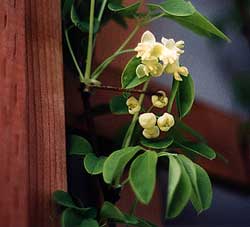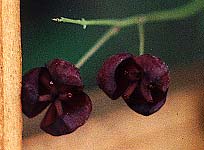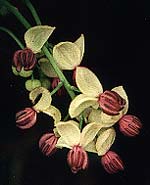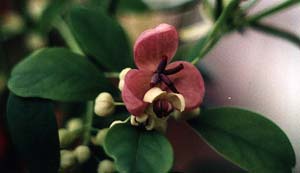 Differing Blooms on Three Varieties
Differing Blooms on Three Varieties
of Akebia quinata
"A doctor can bury his mistakes
but an architect can only advise his clients to plant vines."
-Frank Lloyd Wright
(1868-1959)
but an architect can only advise his clients to plant vines."
-Frank Lloyd Wright
(1868-1959)
Some of the literature says that akebia blossoms aren't significant because so small the leaves hide such little blooms. I have to assume akebia behaves differently in different regions, because here on Puget Sound the blooms begin appearing late March & last through April as very pleasant & overt.
 On Puget Sound akebia is only semi-evergreen, so about two-thirds of its leaves have been lost by March & new leaves begin to fluff this vine out anew later than the blooms begin. Therefore when the blooms arrive, they are numerous & very visible, not at all hidden by leaves. Later in April the arbor begins to fill out completely with leaves, so the remaining blooms might be regarded as less obvious, but still a wonderful addition.
On Puget Sound akebia is only semi-evergreen, so about two-thirds of its leaves have been lost by March & new leaves begin to fluff this vine out anew later than the blooms begin. Therefore when the blooms arrive, they are numerous & very visible, not at all hidden by leaves. Later in April the arbor begins to fill out completely with leaves, so the remaining blooms might be regarded as less obvious, but still a wonderful addition. At dusk early in April (2004) I stepped out on the back stoop & immediately smelled a delightful odor. I didn't know what it was so went about from flower to flower, going, hmm, nice, but that's not it, no, that's not it either.
It was of course the akebia, which for this year was particularly thick with white blooms, from high above the arbor to right down to the ground. I went round back to where there were other akebias on a big trellis. Those smelled even stronger, distinctly of Allspice, though the one on the arbor was more like a vanilla candy. The scent must vary considerably, & chang from day to day. The name "chocolate vine" comes from the flower smelling of chocolate to some people, but our vines are much more like vanillas & spices.
Funny I'd not noticed this scent in past years. Maybe it doesn't develop such a distinct perfume every year. Perhaps in the past I'd mistaken it for one or another flowering shrub & never really checked. Or perhaps there weren't enough of the flowers in past years to make such a startling impression. The scent is probably only present at dusk for a very few days, when the vines are most eager for pollinators.
 The early April picture at the head of the page is Akebia quinata 'Albiflorus' with dangly-bell blooms. These bells open into small three-pointed stars toward the end of April, & some of them puff up to over twice the size before opening. The larger pistilate blooms are the females, & the racemes of smaller flowers are males, for akebia produces both sexes of flowers on each vine.
The early April picture at the head of the page is Akebia quinata 'Albiflorus' with dangly-bell blooms. These bells open into small three-pointed stars toward the end of April, & some of them puff up to over twice the size before opening. The larger pistilate blooms are the females, & the racemes of smaller flowers are males, for akebia produces both sexes of flowers on each vine.The blooms don't self-pollinate very well if at all, & it is rare the vines set even a random fruit unless there is a completely different variety with which to cross-pollinate, plus plenty of early spring bees in the vicinity. For this reason we now have three different akebia cultivars, each looking pretty much identical so far as the arrangement of the leaves in sets of five are concerned, but each having differing flowers.
We've had two Albiflorus growing over an arbor for some while, plus a third one on a home-made trellis attached to our porch-deck. Neither of these vines produced any fruit when we had only that one variety. So we added two other varieties in spring of 2002. Although I didn't expect instant gratification, the following autumn we were able to taste our very first edible akebia fruits which are shown on their own page.
 The second photo above shows the second variety we planted, A. q. 'Chocolate Vine' which has ever so slightly smaller leaves than does the Albiflorus. The flowers are purple (some say chocolaty-purple) bells that open into cupping three-pointed stars. This one is now busily threading its way through the established akebia, sharing the same arbor.
The second photo above shows the second variety we planted, A. q. 'Chocolate Vine' which has ever so slightly smaller leaves than does the Albiflorus. The flowers are purple (some say chocolaty-purple) bells that open into cupping three-pointed stars. This one is now busily threading its way through the established akebia, sharing the same arbor.The third variety was planted around the corner from the other Albiflorus which is growing on the trellis I made from fallen tree limbs. That one is A. q. 'Silver Bells' shown in the third & forth photos on this page. This is the one that successfully pollinated that particular 'Albiflorus' the very first year they were together.
'Silver Bells' has white bell-flowers which open in late April to reveal purple interiors, as shown in the third picture. Additionally it has growing on the same vine a scattering of considerably larger blooms (the females) which are completely different in appearance, dull rose-purple star-flowers. One of these is shown in the final photo.
'Silver Bells' is definitely the most colorful & unusual of the three varieties' blooms, though when not in bloom the vines are not much different from one another.
A note on the photographs: It amazes me that even an amateur garden photographer can get something really interesting-looking on film now & again. The third photo above was shot on a rainy overcast day, & the area behind the vine was empty space underneth the deck. Totally by accident something about the lighting made it look like a Victorian flower painting against a totally flat black background, but it really is just another of my photographs. If I could make photos like that on purpose instead of by accident once in a great while, I'd turn professional!